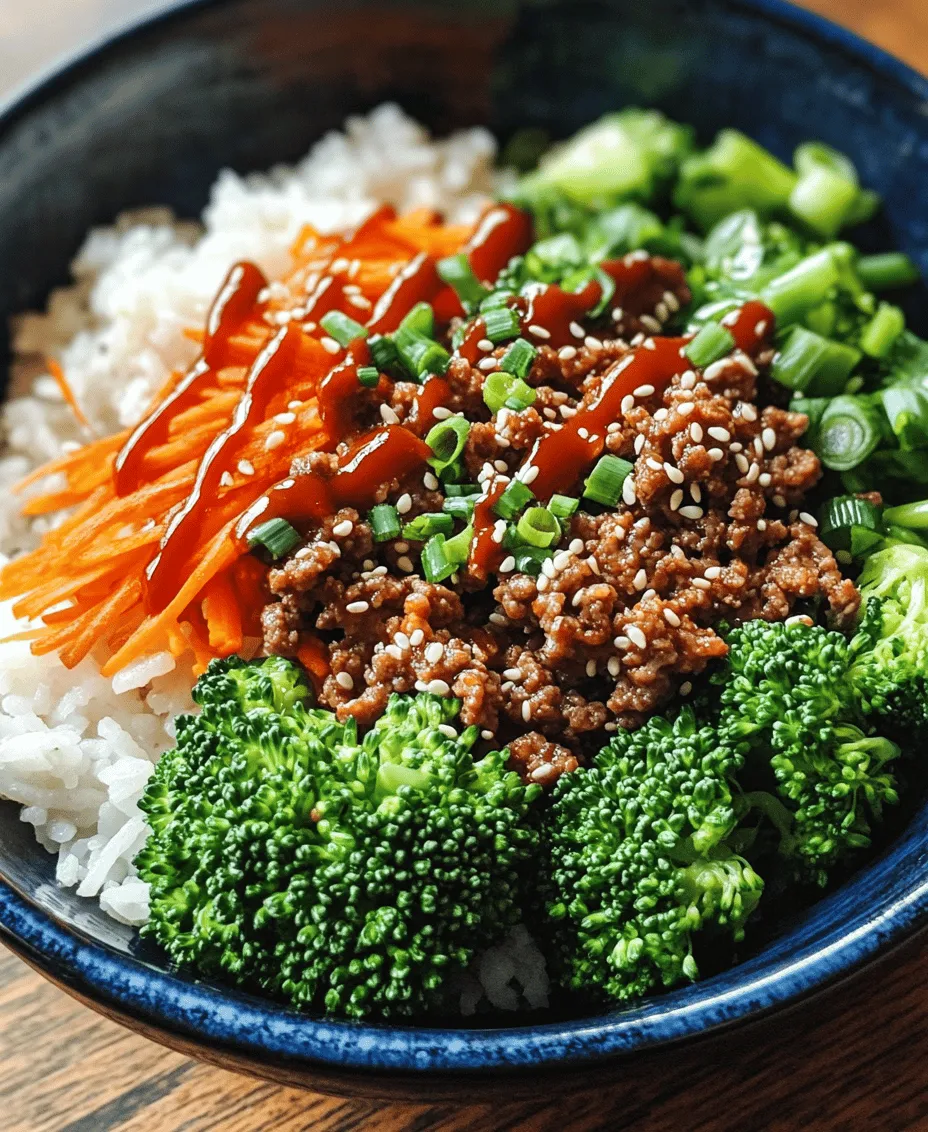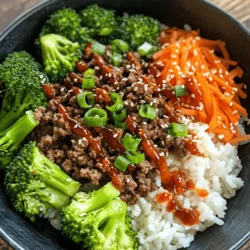Introduction
Korean cuisine has taken the culinary world by storm, captivating food enthusiasts with its vibrant flavors, unique ingredients, and beautiful presentations. From the famous kimchi to savory barbecue dishes, Korean food offers a delightful mix of taste and nutrition that appeals to a wide audience. Among the many dishes that embody this culinary tradition, the Korean Beef Bowl stands out as a scrumptious and easy-to-make option that perfectly balances savory and sweet flavors with a medley of fresh vegetables.
The Korean Beef Bowl is not only delicious but also a nutrient-rich meal that can be prepared in under 30 minutes, making it an ideal choice for busy weeknights or casual gatherings. This dish features tender ground beef, a symphony of flavors from soy sauce and sesame oil, and an array of colorful vegetables, all served over a bed of rice. Each bite offers a harmonious blend of taste and nutrition, making it a favorite for families and food lovers alike.
Understanding Korean Flavors
To fully appreciate the Korean Beef Bowl, it’s essential to understand the key ingredients that contribute to the rich, layered flavors characteristic of Korean cooking. At the heart of this dish are two staples: soy sauce and sesame oil, both of which play a critical role in defining the dish’s flavor profile.
Soy Sauce: The Foundation of Flavor
Soy sauce is a quintessential ingredient in Korean cuisine, providing a deep umami flavor that enhances the overall taste of dishes. There are several types of soy sauce available, including light soy sauce, dark soy sauce, and even sweet soy sauce. For the Korean Beef Bowl, a good quality light soy sauce is typically used, as it adds saltiness without overpowering the other flavors. The saltiness of the soy sauce balances beautifully with the sweetness of other ingredients, such as brown sugar, creating a well-rounded flavor experience.
Sesame Oil: Aromatic and Nutty
Another essential component of the Korean Beef Bowl is sesame oil, which imparts a rich, nutty aroma and flavor. This oil is made from toasted sesame seeds, and just a small amount can elevate the dish significantly. In addition to adding flavor, sesame oil has health benefits, including anti-inflammatory properties and rich antioxidants. The use of sesame oil is not just for taste; it also enhances the overall sensory experience of the dish, making it irresistible.
Fresh Vegetables: The Colorful Crunch
Korean cuisine is well-known for its reliance on fresh vegetables, which provide not only color and texture but also essential nutrients. In the Korean Beef Bowl, vegetables like broccoli and carrots play a vital role. Broccoli is a fantastic source of vitamins C and K, as well as fiber, while carrots are packed with beta-carotene and antioxidants. The inclusion of these vegetables not only enriches the dish nutritionally but also adds a delightful crunch that complements the tender beef and the soft rice.
Ingredient Breakdown
Creating a delicious Korean Beef Bowl starts with the right ingredients. Here’s a closer look at each component and its significance in the dish:
Ground Beef: Choosing the Right Meat
The star of the Korean Beef Bowl is ground beef, which should be chosen carefully for the best flavor. Look for ground beef with a higher fat content, such as 80/20 (80% lean meat and 20% fat), as this will yield a juicier and more flavorful result. The fat helps to keep the beef moist during cooking and contributes to the overall richness of the dish.
Soy Sauce: Types of Soy Sauce and Their Impact
As mentioned earlier, soy sauce is a key ingredient that should not be overlooked. While light soy sauce is commonly used, some recipes may call for a combination of light and dark soy sauce to add depth to the flavor. Dark soy sauce is thicker and sweeter, making it an excellent choice for adding color and a richer taste. Experimenting with different types of soy sauce can help tailor the dish to your personal preferences.
Brown Sugar: Balancing Savory and Sweet Flavors
Brown sugar is another crucial ingredient in the Korean Beef Bowl. Its molasses content gives it a rich, complex flavor that balances the savory notes of the soy sauce and the umami of the beef. The sweetness from the brown sugar helps to mellow out the saltiness and create a well-rounded flavor profile. Using brown sugar also adds a hint of caramelization during cooking, enhancing the dish’s overall taste.
Garlic and Ginger: Flavor Enhancers with Health Benefits
Garlic and ginger are essential aromatics in many Asian dishes, including the Korean Beef Bowl. Both ingredients not only provide bold flavors but also offer health benefits. Garlic is known for its immune-boosting properties, while ginger aids digestion and has anti-inflammatory effects. When sautéed together, garlic and ginger create a fragrant base that elevates the entire dish, making it more aromatic and appetizing.
Vegetables: Nutritional Value of Broccoli and Carrots
The addition of fresh vegetables, particularly broccoli and carrots, not only complements the dish visually but also boosts its nutritional value. Broccoli is rich in vitamins, minerals, and antioxidants, while carrots are an excellent source of beta-carotene, which is vital for eye health. Including these vegetables in your Korean Beef Bowl ensures a well-balanced meal that supports overall health and well-being.
Rice: White vs. Brown Rice for This Recipe
When it comes to serving your Korean Beef Bowl, the choice of rice can make a difference in flavor and nutrition. White rice, often used in traditional recipes, is soft and fluffy, providing a neutral base that absorbs the flavors of the beef and sauce. On the other hand, brown rice offers a nuttier flavor and a chewier texture, along with added fiber and nutrients. Depending on your dietary preferences, you can choose either white or brown rice for this dish, ensuring it aligns with your nutritional goals.
Optional Ingredients: Sriracha and Sesame Seeds for Finishing Touches
To elevate your Korean Beef Bowl even further, consider adding optional ingredients such as Sriracha for a spicy kick or sesame seeds for a crunchy texture. Sriracha can be drizzled over the top for those who enjoy a bit of heat, while sesame seeds can be sprinkled as a garnish, adding visual appeal and a nutty flavor. These finishing touches can take your dish from ordinary to extraordinary, impressing your family and friends.
Preparation Steps in Detail
Now that we have a solid understanding of the ingredients that make up the Korean Beef Bowl, let’s dive into the preparation steps for crafting this delightful dish.
Step 1: Gather Your Ingredients
Before you begin cooking, gather all your ingredients to ensure a smooth cooking process. Having everything prepared and measured will make the cooking experience more enjoyable and efficient.
Step 2: Heat the Skillet with Sesame Oil
Start by heating a large skillet over medium-high heat. Once the skillet is hot, add a tablespoon of sesame oil. This oil not only adds flavor but also helps prevent the beef from sticking to the pan. Allow the oil to heat up until it shimmers, indicating that it is ready for cooking.
Step 3: Sauté Garlic and Ginger
Next, add minced garlic and ginger to the hot skillet. Sauté these aromatics for about 30 seconds until they become fragrant, being careful not to burn them. The aroma of sautéing garlic and ginger is incredibly enticing and sets the stage for the deliciousness to come.
Step 4: Cook the Ground Beef
Once the garlic and ginger are fragrant, add the ground beef to the skillet. Use a spatula to break it apart and cook until it is browned and cooked through, about 5-7 minutes. Stir occasionally to ensure even cooking and to break up any lumps.
Step 5: Add Soy Sauce and Brown Sugar
After the beef is cooked, it’s time to add the soy sauce and brown sugar. Pour the soy sauce over the beef and sprinkle the brown sugar on top. Stir well to combine, allowing the beef to absorb the flavors. Let the mixture simmer for a couple of minutes so that the flavors meld together and the sauce thickens slightly.
Step 6: Incorporate the Vegetables
Once the beef is well-coated with the sauce, it’s time to add in the broccoli and carrots. Stir them into the mixture, allowing them to cook for another 3-4 minutes until they are slightly tender but still retain their crunch. This step not only adds nutrition but also creates a colorful presentation.
Step 7: Prepare the Rice
While the beef and vegetables are cooking, prepare your rice according to package instructions. Whether you opt for white or brown rice, follow the recommended cooking times to ensure it is fluffy and ready to serve.
Step 8: Assemble Your Bowl
Once everything is cooked, it’s time to assemble your Korean Beef Bowl. Start by placing a generous scoop of rice at the bottom of each bowl. Top it with the beef and vegetable mixture, ensuring a colorful presentation. For those who enjoy a bit of heat, drizzle some Sriracha over the top and finish with a sprinkle of sesame seeds for added texture and flavor.
Enjoy the process of creating this Korean Beef Bowl, as each step brings you closer to a delicious meal that showcases the wonderful flavors of Korean cuisine. The combination of savory beef, fresh vegetables, and aromatic seasonings will surely delight your taste buds and leave you craving more.

Cooking Ground Beef: Tips for Achieving the Perfect Texture
To create a delicious Korean beef bowl, the foundation lies in the quality of the ground beef and the cooking technique. Start by selecting high-quality ground beef with a good fat content—ideally around 80/20 (meat to fat ratio). This fat ensures flavor and moisture, which are essential for a satisfying dish.
When cooking the ground beef, follow these steps for optimal results:
1. Preheat the Pan: Use a large skillet or wok and heat it over medium-high heat. This ensures that the beef sears quickly, locking in juices and flavors.
2. Avoid Overcrowding: If you have a large quantity of beef, cook it in batches instead of adding it all at once. Overcrowding the pan can steam the meat instead of browning it, resulting in a less appealing texture.
3. Break It Up: As the beef cooks, use a wooden spoon or spatula to break it apart into small chunks. This promotes even cooking and prevents clumping.
4. Watch for Color Change: Brown the beef until it is fully cooked, with no pink remaining. This usually takes about 7-10 minutes. The browning process also adds depth of flavor.
5. Drain Excess Fat: If there is any excess fat after cooking, drain it to prevent the dish from becoming greasy. However, leave a little for flavor.
By following these tips, you will achieve perfectly textured ground beef that pairs wonderfully with the other ingredients in your Korean beef bowl.
Mixing in Soy Sauce and Brown Sugar: Ensuring an Even Distribution
Once your beef is cooked, it’s time to elevate the flavor profile by adding soy sauce and brown sugar. These two ingredients are key to achieving the characteristic sweet and savory balance of Korean cuisine.
1. Use Quality Soy Sauce: Opt for low-sodium soy sauce to control the saltiness of your dish. This allows you to enjoy the rich umami flavor without overwhelming the palate.
2. Dissolve the Brown Sugar: To ensure the brown sugar mixes well, sprinkle it over the cooked beef while still on the heat. Stir continuously until the sugar dissolves completely. This prevents clumping and promotes an even sweetness throughout the dish.
3. Taste and Adjust: After mixing in the soy sauce and brown sugar, taste the mixture. You can always add a bit more soy sauce for saltiness or sugar for sweetness, based on your personal preference.
4. Incorporate Other Flavors: Consider adding minced garlic and ginger at this stage to enhance the flavor further. Sauté these aromatics for a minute before adding the soy sauce and brown sugar for a fragrant base.
Steaming Broccoli: Best Methods for Retaining Nutrients and Color
Broccoli adds a nutritional boost and vibrant color to your Korean beef bowl. To prepare it, steaming is the preferred cooking method as it preserves nutrients and maintains the bright green hue.
1. Prepare the Broccoli: Wash and cut the broccoli into bite-sized florets. This ensures even cooking and allows for easy eating.
2. Use a Steamer Basket: Place the broccoli in a steamer basket over boiling water. Cover with a lid and steam for approximately 4-5 minutes. This method cooks the broccoli quickly while retaining its crunch and color.
3. Check for Doneness: The broccoli should be tender yet crisp. To test, pierce a floret with a fork; it should go through easily but shouldn’t be mushy.
4. Shock with Cold Water: After steaming, immediately transfer the broccoli to a bowl of ice water. This technique, known as shocking, stops the cooking process and locks in the bright green color.
Combining Ingredients: Achieving the Right Proportions for Flavor
Now that you have your beef mixture and steamed broccoli, it’s time to bring them together in a harmonious blend. Here’s how to achieve the right proportions for a flavorful Korean beef bowl:
1. Base Layer of Rice: Start with a serving of steamed rice as your base. The rice will absorb the juices from the beef and sauce, enhancing the overall flavor. Aim for about one cup per serving.
2. Balanced Beef and Broccoli Ratio: For each bowl, aim for about 1/2 cup of the cooked beef mixture and 1/2 cup of steamed broccoli. This ratio ensures you get a good balance of protein and vegetables.
3. Mixing the Components: Before serving, gently toss the beef and broccoli together in the skillet to coat the vegetables with the sauce. This allows every bite to be flavorful.
Presentation Tips for Serving in Bowls
The visual appeal of your Korean beef bowl can enhance the dining experience. Here are some tips for presenting your dish beautifully:
1. Layering: Start with a base of rice, then add the beef and broccoli mixture on top. This layering not only looks appealing but also allows the flavors to meld together beautifully.
2. Garnish: Consider garnishing with sesame seeds, sliced green onions, or a sprinkle of chili flakes for an extra pop of color and flavor. These toppings can elevate the dish’s visual presentation.
3. Serve with a Side: Include a small side of kimchi or pickled vegetables for a classic Korean touch. This adds variety and enhances the meal’s overall flavor profile.
Nutritional Analysis
A well-rounded Korean beef bowl is not only delicious but also nutritious. Here’s a breakdown of the nutritional values you can expect per serving:
– Calories: Approximately 450-500
– Protein: 30-35 grams
– Carbohydrates: 50-60 grams
– Fat: 15-20 grams
– Fiber: 4-5 grams
Benefits of Balancing Protein, Vegetables, and Carbohydrates
This dish offers a healthy balance of macronutrients:
– Protein: The ground beef provides a substantial amount of protein necessary for muscle repair and growth, making it an excellent post-workout meal.
– Vegetables: Broccoli adds vitamins, minerals, and fiber, contributing to better digestion and overall health.
– Carbohydrates: The rice serves as an excellent source of energy, perfect for fueling your day.
Discussion on How This Dish Fits into a Healthy Diet
The Korean beef bowl can easily fit into a healthy diet when prepared with mindful ingredient choices. Opting for lean cuts of meat, whole-grain rice, and plenty of vegetables ensures that you are maximizing your nutrient intake while enjoying a satisfying meal.
Variations and Customizations
The versatility of the Korean beef bowl allows for numerous variations and customizations to suit your dietary preferences:
1. Protein Alternatives: If you prefer not to use beef, consider substitutions like ground chicken, turkey, or even tofu for a plant-based option. Each alternative provides unique flavors and textures.
2. Vegetarian Version: For a vegetarian Korean beef bowl, swap the ground beef with a combination of crumbled tofu or tempeh sautéed with soy sauce, garlic, and ginger. This keeps the dish hearty and satisfying.
3. Spice Level Adjustments: Adjust the heat to your liking by adding gochujang (Korean chili paste) or red pepper flakes to the beef mixture. Start with a small amount and gradually increase until you reach your desired spice level.
4. Additional Toppings and Sides: Enhance your bowl with toppings like avocado slices, a fried egg, or fresh herbs such as cilantro or basil. Serve alongside a refreshing cucumber salad or miso soup for a complete meal.
Cultural Significance of the Korean Beef Bowl
Korean cuisine is rich in history and cultural significance, with dishes like the Korean beef bowl reflecting the communal spirit of Korean dining.
Historical Context of Korean Comfort Food and Its Evolution
Historically, Korean food has been shaped by the availability of ingredients and the influence of neighboring countries. Rice bowls have become emblematic of Korean comfort food, providing a simple yet satisfying meal that resonates with many.
The Role of Rice Bowls in Korean Dining Culture
In Korean culture, rice bowls symbolize togetherness and family. Meals are often shared, with everyone enjoying a communal dish that encourages conversation and bonding. The Korean beef bowl exemplifies this tradition, making it a popular choice for family gatherings.
How This Dish Reflects Communal Eating and Family Gatherings
Sharing a Korean beef bowl with loved ones fosters a sense of community and warmth. The act of serving and enjoying food together strengthens familial ties, making the dish not just a meal but an experience.
Conclusion
The Korean beef bowl is a delightful combination of flavors, textures, and cultural significance. Its simplicity and deliciousness make it a perfect dish for weeknight dinners or special occasions.
Whether you choose to stick to the classic recipe or explore the many variations, this dish offers a unique opportunity to experience the rich flavors of Korean cuisine. We encourage you to try this recipe, share it with family and friends, and savor the comforting essence of a homemade Korean beef bowl. With its versatility, it can fit into any meal plan, making it a staple in your culinary repertoire. Enjoy the journey of cooking and the delightful flavors that await you!


